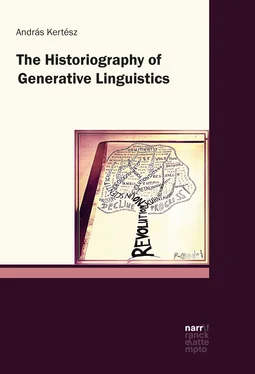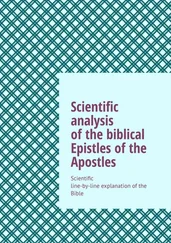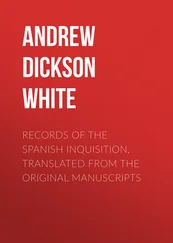Ten HackenHacken, Pius’s second main claim is his answer to the question of whether the transition from Post-BloomfieldianBloomfieldian structuralismstructuralism to generative transformationaltransformation grammargrammar corresponds to a scientificscientific revolutionrevolutionscientific. He discusses the basic issues of post-Bloomfieldian linguistics and then analyses both the latter’s continuities with and differences from early generative linguistics. He argues that Post-Bloomfieldian and Chomskyan linguistics are incommensurableincommensurable , and therefore they constitute two different research programresearchprograms. Applying the new definition of ›revolution‹ (i.e. ›revolution‹ as a change of research program), he reaches the following conclusion, which we have already anticipated in (T2):
The emergence of Chomskyan linguistics was a revolution because it is based on a different research programresearchprogramme from Post-BloomfieldianBloomfieldian linguistics and gradually replaced the latter.
The Chomskyan revolution can be seen as progressprogress because it replaced the emphasis on procedures applied to the set of datadata by a productive interaction of hypotheses and tests in the empirical cyclecyclic (ten HackenHacken, Pius 2007: 179; emphasis added).
In addition to his historical analyses, ten HackenHacken, Pius also discusses the synchronic relations of Chomskyan linguistics to further trends which the literature often considers as belonging to the generative movement (SellsSells, Peter. 1985, NewmeyerNewmeyer, Frederick J. 1998). Ten Hacken’s considerations reveal both the common components and the differences between Chomskyan linguistics and four further theories: Lexical-Functional GrammarLexical-Functional Grammar (LFG), Generalized Phrase Structure GrammarGeneralized Phrase Structure Grammar (GPSG), Head-driven Phrase Structure GrammarHead-driven Phrase Structure Grammar (HPSG), and JackendoffJackendoff, Ray’s linguistics. Showing that these four frameworks are different research programresearchprograms and that they must not be simply subsumed under what Newmeyer (1998: 7) calls ›the generativist orientation‹, is an interesting claim (see also Section 6.2.1).
In summary:3
| (SP3) |
The basic terms of the historiographyhistoriography of generative linguistics are ›research program‹researchprogram and ›scientificscientific revolution‹revolutionscientificevolutionscientific in the intellectual sense with respect to Syntactic Structures; Syntactic Structures its central hypothesis is (T3) and its framework is the methodologymethodology of scientific inquiry as put forward in ten HackenHacken, Pius (2007). |
2.1.1.2.2 Laudanian revolutionrevolutionLaudanian
That there is enormous uncertaintyuncertainty regarding the application of the KuhnianKuhnian term ›scientificscientific revolutionrevolutionscientific‹ to linguistics is well illustrated not only by the change in KoernerKoerner, E.F. Konrad’s views already mentioned and to be discussed later in the present work, but also by the way NewmeyerNewmeyer, Frederick J. revised his own views. Newmeyer has been in argument with Koerner for decades, and while the views of both of them have taken various turns, Newmeyer typically argues against Koerner’s opinions. The changes in Newmeyer’s views are especially interesting because many consider him the ›official historian‹ of generative linguistics, who effectively represents ChomskyChomsky, Noam’s interests (see e.g. MatthewsMatthews, Peter H. 1993: 208, TomalinTomalin, Marcus 2008: 13, 16; LakoffLakoff, Robin 1989, MurrayMurray, Stephen O. 1994, HarrisHarris, Randy Allen 1993a etc.). Although Newmeyer used the term ›Chomsky’s revolution‹ in the first edition of his book Linguistic Theory in America , he did not clarify in what sense Chomsky’s appearance has in fact been revolutionaryrevolutionary (Newmeyer 1980). However, he did cite KuhnKuhn, Thomas S. (1970)[1962] in the second edition (Newmeyer 1986a: 36–37). Subsequently, Newmeyer modified his approach in the paper in which he responded to Koerner (1983) and in which he rejected the term ›scientific revolution‹ in the Kuhnian sense (Newmeyer 1986b; for more on this, see also Section 3.1.1.1). He argues for the following thesis:
| (T4) |
Syntactic Structures Syntactic Structures triggered a scientificscientific revolutionrevolutionscientific in the sense of LaudanLaudan, Larry (1977) rather than in the KuhnianKuhnian (1970) sense and thus led to a new ›research tradition‹researchtradition. |
NewmeyerNewmeyer, Frederick J.’s first argument supporting (T4) is that ChomskyChomsky, Noam’s Syntactic Structures Syntactic Structures has brought intellectual innovation into linguistics. When attempting to justify the intellectually revolutionaryrevolutionary nature of Syntactic Structures , Newmeyer partly relies on the same factors as KoernerKoerner, E.F. Konrad (1978) (see Section 2.1.1.1) without, however, referring to the ›climate of opinionclimate of opinion‹. As further factors he mentions
the revolutionaryrevolutionary importance of the central role of syntax;
related to the central role of syntax, the interdisciplinary nature of the ›revolution‹, which has brought – first and foremost – psychology and philosophy within its scope; as well as
the successful adaptation and synthesis of the progressive elements of American structuralismstructuralism.
According to his second argument, Syntactic Structures Syntactic Structures was revolutionaryrevolutionary from a sociologicalsocial perspective as well, but it is problematic that historiographers use conflicting criteria to separate revolutionary from non-revolutionary achievements and that »[p]aradoxiocally, however, the sociological transformationtransformation of the field has not been accompanied by a corresponding success on the part of generative grammarians in achieving institutional power« (NewmeyerNewmeyer, Frederick J. 1986b: 2). Newmeyer admits that generative linguistics does not meet two necessary requirements of KuhnianKuhnian revolutionrevolutionKuhnians. First, he approvingly quotes PercivalPercival, W. Keith (1976a: 289), according to whom generative linguistics has not been generally accepted within the discipline. He concludes »if KuhnKuhn, Thomas S. is correct, no (scientificscientific) revolutions have occurred in linguistics. […] the ›Chomskyan revolution‹, if there was one, was not a ›Kuhnian revolution‹.« (Newmeyer 1986b: 6, emphasis added). Second, the appearance of Syntactic Structures had not been preceded by a crisiscrisis:
The Chomskyan revolution failed to meet KuhnianKuhnian conditions in another respect. For KuhnKuhn, Thomas S. (74–5), a revolution is in part a response to ›crisiscrisis‹ – to a situation in which, in the ›typical‹ case, there is ›a profound failure in the normal problem-solving activity‹. Yet far from being in a state of crisis, post-BloomfieldianBloomfieldian structuralismstructuralism in 1957 was enjoying a period of unprecedented optimism , in which it was believed that the fundamental questions of linguistic analysis had all been solved (see NewmeyerNewmeyer, Frederick J. 1980: 1–3). It is rather puzzling, then, that so many commentators, generativist and non-generativist alike, have taken the Chomskyan revolution to exemplify Kuhn’s conception of a scientificscientific revolutionrevolutionscientific […] (Newmeyer 1986b: 7, footnote 6; emphasis added).1
Based on these factors, however, NewmeyerNewmeyer, Frederick J.’s conclusion is not that Syntactic Structures Syntactic Structures did not trigger a revolution, but that it did, although in a non-KuhnianKuhnian sense.2 In answer to the question of what criteria scientificscientific revolutionrevolutionscientifics are based on, he claims LaudanLaudan, Larry (1977: 137–138) provided the correct criterion. Laudan uses the term ›research traditionresearchtradition‹, which is analogous to the Kuhnian term ›paradigmparadigm‹. In Laudan’s view, it is not at the point at which the entire discipline – or at least a definitive part of it – accepts a certain research tradition that a scientific revolution takes place. Rather, a revolution takes place when a research tradition attracts enough attention to make scholars within the field take it seriously, in the sense that they either accept it or consider it a rival. With reference to HymesHymes, Dell (1964: 25), Newmeyer points out that transformationaltransformation generative grammargrammar had become the reference point of research within linguistics by the beginning of the 1960s, and thus it completely conforms to Laudan’s criterion. It has become an accepted routine to explicitly reject ChomskyChomsky, Noam’s theorytheory when alternative approaches are introduced. Therefore, if Laudan’s view is correct, then the Chomskyan revolution has taken place in linguistics in the Laudanian sense (Newmeyer, 1986b: 7–8):
Читать дальше












